
(1910)
One way to approach the orchestra is to treat it like a high-powered Ferrari. Naturally, you want to get behind the wheel and take it for a spin. NCCO has already given us a taste of that with Clarice Assad’s arrangement of Mussorgsky’s Pictures at an Exhibition. Really good composers (like Assad, whose orchestra was half the size of the usual one in that piece) can also do more with less, and not have you notice the economy of means. That’s part of what this program is about.
Serenades were done, originally, to woo women. That (believe it or not) is still a reason to make music, if you take away the gender roles for our modern society. Think of Benjamin Britten, wooing his partner, Peter Pears, for whose voice the Serenade for Tenor, Horn, and Strings was written. The music on this program is honey to the ears, like the songs of a lover. Imagine Dvořák in 1875, flush with the success of a new, more prestigious job, writing the Serenade for Strings in E Major, for his young wife, whom he had married only two years earlier. Musicians have never really forgotten the original idea behind serenading and, one way or another, it comes out in the pieces they title serenade.
Listen to the Music
Buciemeana
Maruntel
Now, if you were Hungarian around the turn of the (last) century and were studying at the new musical academy named after Franz Liszt, you would be aware of that composer’s best-loved pieces, including his masterpieces, the Hungarian Rhapsodies. Throw in Brahms’ Hungarian Dances and Dvořák’s Slavonic Dances, and you already have a basis for a favorite 19th-century genre. Well, Béla Bartók had an answer for them all, because he had already transcribed hundreds of real folk fiddle tunes by 1915 when he wrote his Romanian Dances. Bartók actually seems to arrange this folk music, though it is to some degree also composed. Again, they are easily the composer’s most popular pieces, and if you hear something of the 19th-century “Hungarian style” in them, that is by design, as if the composer were saying to Liszt, “That’s a pretty good rhapsody, Franz, but now check this out!”

